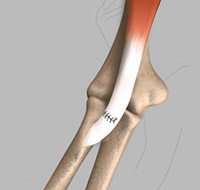Distal Biceps Tendon Repair

The biceps muscle is located in front of your upper arm. It helps in bending your elbow as well as in rotational movements of your forearm. Also, it helps to maintain stability in the shoulder joint. The biceps muscle has two tendons, one of which attaches it to the bone in the shoulder and the other attaches at the elbow. The biceps tendon at the elbow is called the distal biceps tendon and if there is a tear in this tendon, you will be unable to move your arm from the palm-down to palm-up position. Once the distal biceps tendon is torn, it cannot grow back to the bone and heal by itself. Permanent weakness during rotatory movements of the forearm may occur if the tendon is not repaired surgically.
There are several procedures to accomplish reattachment of the distal biceps tendon to the forearm bone. Some techniques require two incisions while in others one incision may be sufficient. In some cases, the tendon is reattached using stitches passed through holes drilled in the bone. Sometimes, a small metal implant may be used to attach the tendon.
How is the procedure performed?
During distal biceps tendon repair, your surgeon makes a small incision over the upper forearm, where the biceps muscle attaches to the radius bone. The torn biceps tendon is brought up through the incision. Then, the radius bone is prepared for tendon reattachment and to promote healing. Two suture anchors will be inserted into the bone. These serve as anchorage for the tendon. The sutures from the suture anchors are passed through the tendon in a particular interlocking manner so as to ensure a strong tendon repair.
What are the steps taken for post-operative care?
After the repair is complete, a hinged elbow brace will be applied with your elbow bent at 90 degrees. The brace will be removed after 6 weeks and it may take up to 6 months -1 year to regain full strength.
What are the associated risks and complications?
Complications are rare and may include numbness and weakness in the forearm, formation of new bone, limited movement, and re-tearing may occur.
Further information:
You will need the Adobe Reader to view and print these documents.![]()







